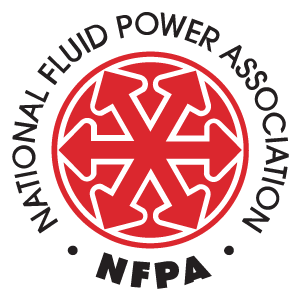By Eric Lanke
NFPA President/CEO
At our recent Annual Conference in Laguna Beach, California, I shared the key ways NFPA is fulfilling its mission to strengthen the fluid power industry. In this, the fourth NFPA News post in this series, I’d like to share some of the things I said regarding NFPA’s objective to increase the number of technical college students educated in fluid power, and to connect them to careers in our industry.
In our biennial membership survey, NFPA members consistently rank workforce development as the most challenging issue their companies face. The NFPA Foundation was created to help meet this need. Through its donors, the Foundation provides the resources necessary to develop fluid power education at multiple grade levels, and through its committees and connection opportunities, it brings its supporters face to face with the new talent being developed by those programs.
To create more fluid power-educated technical college graduates, the NFPA and the NFPA Foundation conduct a number of student outreach and education programs, designed to create a pathway into the fluid power industry.
We are building a series of programs that first introduce fluid power in middle school, then provide fluid power educational experiences in high school, then fluid power degrees and certificates in tech schools, and finally connections to jobs in the fluid power industry.
Building Fluid Power Awareness Among Middle School Students
Our middle school program is the Fluid Power Action Challenge. This is a competition that challenges middle school students to solve an engineering problem using fluid power. The students work in teams to design and build a fluid power mechanism, and then compete against other teams in a timed competition. Right now, there are two ways to get students involved in this program.
One way is through the Fluid Power Action Challenge grants that we offer teachers to help bring Challenge materials into classrooms across the country. To date, these small grants have been given to teachers in 115 schools, who have, as a result, brought fluid power to more than 8,700 students.
But the second way is through the many Fluid Power Action Challenge events, hosted and organized by NFPA members and partners across the country. Since the program launched, 26 different organizations have hosted 87 different events. Together with the schools receiving grants, they have helped our program reach more than 17,500 students.
Engaging High School Students in Fluid Power Education
Many of the middle school students who first learn about fluid power in our Action Challenge go on to participate in STEM education activities in high school. One of the most popular high school STEM competitions is FIRST Robotics. The NFPA Foundation is helping to ensure that FIRST students use fluid power in their robot designs.
Our Fluid Power Robotics Challenge is a scholarship program that awards one merit-based scholarship each year to a high school student who uses fluid power in his or her FIRST robot. It is a significant award — $10,000 per year for up to four years to be used to study engineering at any accredited U.S. tech school or university.
Each year, the number of scholarship applications we receive increases, and now we’ve expanded the program to include high school students participating in National Robotics League competitions. Our Foundation is helping to bring fluid power into these national programs, and we’re successfully introducing tens of thousands of high school students to our technology.
FAMTEN Hubs
In order to talk about our second High School program, I have to introduce you to the strategy we call FAMTEN – the Fluid Power and Applied Mechatronics Training and Employment Network.
FAMTEN is helping us address one of the remaining shortcomings of our current activities – and that is the way that many of our programs are scattered in different communities. There’s a strong middle school program in one place, a strong high school program in another, and a strong tech school program in a third. To truly build the reliable pathway we envision, we need to stack all three programs in the same community. And that’s the idea behind FAMTEN.
With the continued support of our donors, we are now building a series of FAMTEN hubs around the country – communities with a tech school that has a validated fluid power and mechatronics degree program, surrounded by a ring of feeder high schools that are teaching fluid power to their students, and supported by a community-wide middle school program to build general fluid power awareness among students and educators.
The donations and active involvement of our industry partners will continue to be essential, both to build these structures and to provide mentorship and employment opportunities to the students in each FAMTEN community.
Last year, the first FAMTEN Hub was launched at Waukesha County Technical College in southeastern Wisconsin. WCTC already had a strong fluid power and applied mechatronics degree program – with more than 200 students currently enrolled – and, through the efforts of our Action Challenge Champions, Waukesha County already had a growing middle school outreach program for fluid power.
By designating WCTC as a FAMTEN Hub school, our Foundation has been able to build the missing piece – a fluid power education program in each of a ring of feeder high schools around WCTC.
High School Fluid Power Labs
We’ve built the ring of feeder high schools by providing grants to eight area high schools to purchase the fluid power training platforms they need to offer targeted fluid power education to their students.
WCTC, as the FAMTEN Hub school, has provided training to the high school teachers so that they can teach the fluid power curriculum associated with their chosen platform – and right now, more than 130 high school students are participating in these classes.
In addition, members of our industry donor coalition, who are helping to support these activities and the growth of future FAMTEN Hubs, are visiting the high school classrooms, and offering mentorship and information on careers in fluid power. As a result, several of the students have already expressed interest in continuing their fluid power education at WCTC following their high school graduation.
Fluid Power Scholarships
To provide an additional incentive for the high school students to continue their fluid power education, the NFPA Foundation has also started a new scholarship program.
Thanks to a transfer of assets from the now-defunct Fluid Power Educational Foundation and an on-going series of annual gifts from the International Fluid Power Society, the NFPA Foundation has set up a dedicated scholarship fund that has already awarded twelve $2,000 scholarships to students interested in studying fluid power at one of our education partner institutions.
Starting with our next fiscal year – and assuming we can generate the donations necessary to support it – a guaranteed number of scholarships will be offered for students wishing to attend each FAMTEN Hub school.
Future FAMTEN Hubs
Because, of course, the plan is to increase the number of FAMTEN Hubs around the country.
The industry donors and leaders that serve on our Tech School Education Committee have already helped us select the location of our second FAMTEN Hub – which will be at Triton College in northeastern Illinois.
And it will be that group that helps determine where additional Hubs will be launched in the future – paying close attention to communities where a dedicated group of fluid power companies can offer the financial support and the volunteer time necessary to build and engage in FAMTEN’s essential programs.
Remember, to create the workforce pathway we seek, we need to stack all three education programs – middle school, high school and tech school – in the same community and engage local NFPA members in offering the corresponding mentorship, internship, and employment opportunities to those students.
If you would like to learn more and become actively engaged with our tech school programs, please contact me at elanke@nfpa.com or (414) 778-3351.
Like this post? Share it!
Recent Posts
NFPA to Present “Digital Fluid Power – Advances & Controls in Hydraulics & Pneumatics” at AUTOMATE on May 8
NFPA members are encouraged to attend the AUTOMATE trade show, to be held May 6-9, 2024 in Chicago, IL. As part of our efforts to provide an effective forum for our members to connect with key end markets in fluid power, NFPA will be organizing a panel discussion on “Digital Fluid Power” on the AUTOMATE…
NFPA Surveys as Leading Indicators
Looking for a strong leading indicator to help plan forward over the next couple quarters? Look no farther than the NFPA State of Fluid Power Industry Survey (SOFP). SOFP is easy to participate in each month. Just answer a few quick opinion-based questions via online survey, but the results are powerful. SOFP is a strong…
NAM Regulatory Update: Manufacturers | Unprecedented Use of CERCLA Authority Will Hamper President’s Manufacturing Vision
As part of an effort to bring more information about the regulatory and legal environment facing American manufacturers, NFPA is monitoring the newsfeed of the National Association of Manufacturers (NAM) and will be bringing important updates like this to the attention of NFPA members. These chemicals are sometimes present in hydraulic fluids. Following the release…




